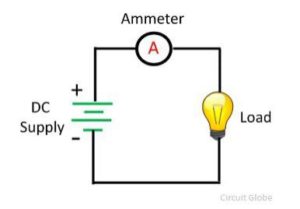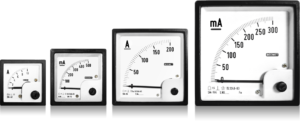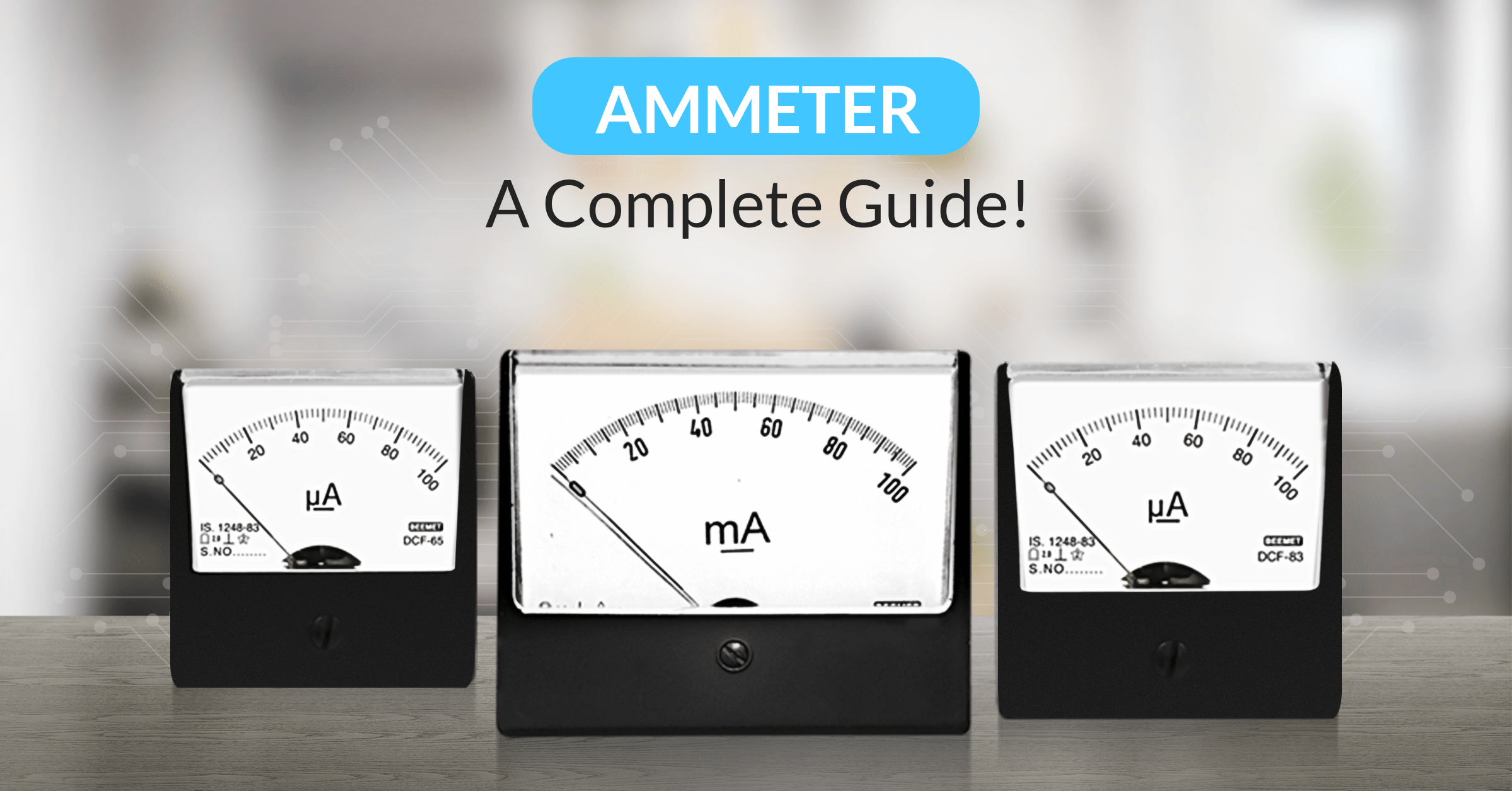An Ammeter has a lot of uses in day-to-day life and is a very important electrical measuring instrument. This complete guide will help you understand what an ammeter is, how an Ammeter works, different types of ammeters, and more.

What is an Ammeter?
An ammeter is a measuring device that measures the flow of current in a circuit. It gives the exact reading of how much current passes through the conductor. Ammeter is derived from the Greek word ‘amps’ which means current.
When the circuit is at rest and current begins to flow, the ammeter immediately shows the current. Most ammeters have little or no electrical resistance and are simply connected in series of the circuit to be measured.
The current flowing through the ammeter causes a direct current to flow through the circuit, causing lights to glow and heating elements to heat up. However, the current drawn by the ammeter itself leads to a much smaller voltage drop across its terminals, so the ammeter can be a more sensitive measure of current than the electrical circuit elements themselves.
Ammeters are commonly used to measure the current drawn by any appliance, machine, motors, pumps, equipment, etc. Ammeters are available as either analog panel meters, or digital panel meters.
Working Principle of an Ammeter
An ammeter is always connected in series with the circuit, so the current passes through it. Inside the ammeter, there’s a tiny wire called a “shunt.”
When the current flows through the wire we aim to measure, a tiny part of the current takes the detour through the shunt. This detour creates a small voltage that’s easy to measure.
The ammeter then uses this voltage to tell us the amount of current passing through the wire. The more current, the higher the reading on the ammeter.
In summary, an ammeter works by using a shunt to measure a small bit of the current, turning it into a voltage, and then showing us the current reading.
Applications of an Ammeter
Ammeters are the current navigators in a variety of situations. From home to industry, they silently play a crucial part in maintaining a balanced current flow and enhancing our electrical experiences. Let’s take a look at their applications:
- Home Wiring Check: Ammeters lend a hand in confirming if your home’s electrical system is running smoothly. By measuring current flow, they ensure that circuits aren’t overloaded, averting potential problems.
- Gadget Performance: By hooking up to devices like your computer or fridge, they unveil their power consumption details.
- Car Troubleshooting: Behind a vehicle’s dashboard, ammeters can uncover if the battery and alternator are matched perfectly. Too much or too little current can point to issues that need fixing.
- Industrial Buzz: Ammeters are like stage managers in factories. They keep tabs on the currents feeding heavy machinery, guaranteeing a smooth performance.
- Renewable Energy Setup: Ammeters can help us monitor and optimize the energy harnessed from solar panels and wind turbines.
- Electronics Creation: They can help fine-tune the components, ensuring they consume the right amount of current.
Advantages of using an Ammeter
Ammeters offer a range of valuable benefits. With their quick and real-time current readings, they act as instant electric traffic inspectors. They prevent potential hazards by detecting and notifying us about overloaded circuits. They pinpoint issues through irregular current patterns. Their ability to reveal the energy consumption of devices empowers us to make energy-efficient choices, leading to both cost savings and reduced environmental impact.
These instruments become indispensable tools, aiding in the design of effective and efficient electronic circuits. In summary, ammeters can be used for enhancing safety, efficiency, and knowledge in the realm of electricity.
Precaution while using an Ammeter
When dealing with an ammeter, a few simple precautions ensure a safe and accurate experience. Make sure to choose the right current range on the ammeter, much like selecting the right gear for driving. Secure and healthy wires are a must.
Remember, an ammeter is a current device so never use it to measure voltage to prevent both meter damage and unsafe situations. Avoid touching metal parts when the circuit is live, and if possible, stick to using one hand during measurements to minimize risks.
Ammeter Reading and Symbol
Current is measured in Amperes and hence Ammeter displays the reading in amperes. In an electric circuit, the ammeter is represented by ‘A’ inside a small circle.

How does an Ammeter work?
In order to measure current in a circuit, it is important to break the circuit open and insert an “ammeter” in series with the circuit. This will allow electrons to flow through the ammeter as well as through the circuit. In few minutes, the ammeter will start showing the amperes in the circuit.
What are the types of Ammeters?
On a broader level, the ammeters are classified in two categories – Types of ammeter depend on the construction and on the measurement of current. Lets look at each one to help us understand their functionality better.
Based on construction:
- Permanent moving coil ammeter (PMCA) : This ammeter is used to measure direct current. Here, the coil is placed between the pole of a permanent magnet. The deflection of the coil depends on how much current flows through it.
- Moving iron ammeter: Used for measuring both direct and alternating current. The deflection of the assembly is proportional to the current that passes through the coil.
- Electro-dynamometer ammeter: Used for measuring both the AC and DC currents. This has more accuracy when compared to the other two instruments.
- Rectifier type ammeter: Generally used for precise measurement of alternating current and finds application in communication circuits.
Based on the measurement of current:
- AC ammeter
An ammeter is a device used to measure current. It comprises of a moving iron movement in which the assembly moves between two jewel bearings. This ammeter is used to measure DC currents. - DC ammeter
DC ammeters are used to measure the current flowing through a conductor. The ammeter is a simple device that has a dial with divisions to indicate the amount of current passing through it. This ammeter is used to measure the current in DC circuits with a frequency of 50 or 60 Hz.
Analog Ammeter
The pointer inside the ammeter moves within a span of 90°. The tip of the pointer corresponds to a numeric value. This is the amps of current passing through the circuit. DC ammeters have linear scales with equal divisions. AC ammeters have non-linear scales with unequal divisions.

What is the range of Ammeter?
The range of an ammeter means the maximum capacity of current it reads. Typically an ammeter has a range of 0-3 ampere and there are 30 divisions on its scales.
E. g. – if you take an ammeter which has a dial 0 —300, it means it can read the current upto 300 amp. For digital meters, no dial will be there, and it reads on the screen up to the capacity mentioned on it.
Where is the ammeter used in daily life?
The ammeter is a device used to measure electric current. It is most commonly used in electrical systems, such as in homes and businesses, to measure the flow of electricity. An ammeter can measure both the DC and AC current. In everyday life, it can be used anywhere to measure the current like in cars, fridges, heaters, sensitive machines, etc.
If you want to find an ammeter that perfectly fits your application requirements- Give our blog on selecting the right ammeter a read.
How to Read an Ammeter?
An ammeter has two terminals on the rear indicated by positive and negative signs. Connect the equipment accordingly. When the equipment is switched on, the ammeter will indicate the current drawn by the equipment.
Ammeter reading is the reading of the deflection of the magnetic needle due to the intensity of the magnetic field created in the ammeter coil caused by the amount of current flowing. So when calibrated they are capable of measuring the amount of current flowing when connected in series in the circuit.
Reading an ammeter is simple, but there are a few things you need to know in order to do so. First, the ammeter has two terminals – the black lead (or “anode”) and the red lead (or “cathode”). The ammeter’s scale is read from left to right, with each number representing a certain amount of current. Second, when measuring current, it’s important to keep in mind that ammeters measure DC current – that is, the current flowing through the meter is constant regardless of how much voltage is present. Finally, always use caution when working with electrical equipment – even small currents can be dangerous if not handled properly!
Conclusion
Beemet is a leading voltmeter, ammeter, and panel meter manufacturer and exporter from India. We have won the trust of many customers around the world by providing high-quality products at competitive prices. Our Ammeters are used in several commercial and industrial applications.
Beemet ammeters are available in various models and sizes to suit the customer’s requirements. They come in:
- Square DIN sizes (48/72/96/144)
- Wide view clear polycarbonate front mounting and rear panel mounting type
- Round meter with glass front-type
- Rectangular sizes
- Wide angle 240° circular scale type
- Educational portable type mounted on a desktop stand
- American type Saxon and Fiesta series.
- Maximum demand indicator / bimetallic ammeters in 2 and 3 pointer types.
The meter housing is made with ABS and polycarbonate plastics. Our ammeters are available in DC permanent magnet moving coil type, AC moving iron type and moving coil rectifier type. The microammeters are available from 25μA – 1000μA, milliammeters from 1mA – 1000mA, ammeters from 1A – 60A (internal shunt), 1A – 10000A (with external shunt) and similar range for AC ammeters with external CT. We also manufacture digital ammeters in various sizes (96×48/96×96/48×48) as well as in compact module form.
Hope this article helped you with a detailed understanding of Ammeters! If you want a walkthrough of a Voltmeter, dive into our dedicated Blog on Voltmeter for an in-depth guide.
Frequently Asked Questions (FAQ’s)
An ammeter is an instrument used to measure the current in electrical circuits. It works on the principle that the magnetic field around a conductor carrying direct current in a circular field with a constant magnitude. The current flow in a conductor is proportional to the area of the loop. When the loop is reduced, the magnetic field is intensified. So the ammeter is placed in series with the circuit to be measured and its coil movement is proportional to the current flow in the circuit. Thus it is a meter for measuring current flow in a circuit.
Voltmeters measure voltage, and ammeters measure current. Voltmeters are used to measure the voltage of a circuit when it is connected in parallel, along with another resistor that limits the effect it has on the voltage source.
The principle of ammeter is based on the magnetic effect of current, its principle is that the resistance and inductive reactance must be low. Ammeter consists of a coil of wire and a fixed permanent magnet. Hence an ammeter can never be connected in a parallel line.
An ammeter basically measures the electric current in a circuit. A voltmeter is being connected in parallel for measuring its voltage whereas an ammeter is connected in series with a device to measure its current.
Ammeters – which is a unit of measurement to determine the amount of electric current flowing through an electrical circuit – work by measuring the current of electricity that passes through a coil, with a very low resistance and inductive reactance. A galvanometer can be converted into an ammeter by hooking up a resistor called a shunt resistance in parallel to the galvanometer.
The major difference between the ammeter and the galvanometer is that while the ammeter only shows magnitude, the galvanometer shows both magnitude and polarity. The ammeter is more likely to measure current in mA, A or even something like kA while the galvanometer may be able to read electric current in micro-amps.




